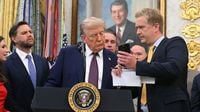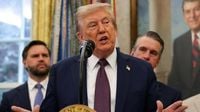Over the Labor Day weekend of 2025, the United States found itself at the center of a bizarre and fast-moving social media firestorm. Instead of the usual end-of-summer barbecues and family gatherings, millions of Americans and onlookers worldwide became engrossed in viral rumors that President Donald Trump was either gravely ill or, as some posts boldly claimed, already dead.
The hashtags #trumpisdead and #whereistrump surged to the top of X (formerly Twitter), while TikTok buzzed with videos speculating about the president’s demise or a secret medical emergency. According to Rolli IQ, a social media monitoring tool cited by Al Jazeera, the phrase “Trump is dead” appeared at least 5,616 times across X, Reddit, YouTube, and Bluesky between August 28 and September 2, racking up more than two million likes and 122,000 shares. Even users in Brazil and Australia joined in, amplifying the rumor’s global reach.
But as the online frenzy reached a fever pitch, reality quickly caught up. On Tuesday, September 2, President Trump appeared live at the White House, standing before reporters in the Oval Office. Fox News reporter Peter Doocy, phone in hand, asked the question on everyone’s mind: “How did you find out over the weekend that you were dead?” According to Axios, Trump responded with a bemused smirk, “Really? I didn’t see that. I have heard. It’s sort of crazy, but last week, I did numerous news conferences. All successful, they went very well. Like this is going very well. And then I didn’t do any for two days, and they said, ‘There must be something wrong with him.’”
Trump insisted he was “very active, actually, over the weekend,” citing interviews, golf outings, and a steady stream of posts on his social media platform, Truth Social. On August 31, he posted, “NEVER FELT BETTER IN MY LIFE.” Yet the online speculation showed no signs of slowing. The president’s six-day absence from major public appearances—the longest since he took office—combined with images of his swollen ankles and bruised hands, fueled the conspiratorial fire. Forbes noted that the president was last photographed Monday outside the White House in golf attire, and earlier that weekend departing with his granddaughter for a round at Trump National Golf Club in Virginia.
It didn’t help that on August 29, Washington correspondent Laura Rozen posted on X that “Trump has no public events scheduled all weekend. Don’t believe he was seen today either.” Her post garnered a staggering 33.9 million views, further stoking the rumor mill. An X account called “Did Donald Trump Die Today?” which had been posting daily “no” updates since December 2024, jumped on the bandwagon with a tongue-in-cheek repost: “Yeah he likely died LOL.” That single post drew 14.3 million views.
But what started all this? The spark, as Al Jazeera reported, was a quote from Vice President JD Vance during an August 28 interview with USA Today. When asked if he was ready to assume the presidency given Trump’s age, Vance replied, “I feel very confident the president of the United States is in good shape, is going to serve out the remainder of his term and do great things for the American people. And if, God forbid, there’s a terrible tragedy, I can’t think of better on-the-job training than what I’ve gotten over the last 200 days.” Despite Vance’s reassurances, social media users seized on his mention of a “terrible tragedy” as proof that something was amiss.
Adding fuel to the fire, a TikTok video posted on September 1 by a self-identified physical therapist claimed to have evidence from Trump’s medical records that he’d suffered a stroke or heart attack. That video alone amassed over three million views before being taken down. Meanwhile, photos circulating online highlighted Trump’s bruised hands and swollen ankles—symptoms that, according to a July statement from the White House physician, were due to chronic venous insufficiency, a common but non-life-threatening condition in people over 70. The bruising, the physician explained, was “consistent with minor soft tissue irritation from frequent handshaking and the use of aspirin, which is taken as part of a standard cardiovascular prevention regimen.”
Despite these official explanations, critics and commentators on both sides of the political spectrum weighed in. Some liberal influencers, such as Aaron Parnas, tried to tamp down the most outlandish rumors, saying in a TikTok on September 1, “But folks, there’s no conspiracy about whether or not Trump is alive. He’s alive. Stop spreading that.” Others, like Ben Meiselas of MeidasTouch, speculated about the president’s health, saying, “It appears to be, and again this is just an opinion, I’m not a doctor, some serious either cardiovascular, kidney or liver issue based on medical professionals I’ve spoken to.”
Conservative voices, meanwhile, pointed out a perceived double standard in media coverage. While Trump has often mocked President Biden’s health and even amplified conspiracy theories about Biden’s supposed “body doubles,” some right-leaning pundits argued that the press was now giving Trump’s own health a pass. According to Axios, the media’s “missteps in covering Biden’s decline” after the 2024 debates remained fresh in the public’s mind, leading some to demand similar scrutiny of Trump’s fitness for office.
Outside the political fray, experts offered historical perspective. Cliff Lampe, a professor at the University of Michigan, noted that rumors of world leaders’ deaths are nothing new. “In the 1940s, rumors of Soviet leader Joseph Stalin’s death circulated. Stalin died in 1953. Former Cuban leader Fidel Castro and Iranian leader Ayatollah Khomeini also ‘had rumours of death before they had actually died,’” Lampe told Al Jazeera. North Korean leader Kim Jong Un and Russian President Vladimir Putin have faced similar speculation. In Lampe’s view, such rumors gain traction when leaders are secretive or when enemies seek to undermine their legitimacy.
Yet, as Forbes pointed out, the White House did not suspend the president’s schedule, and official records continued to chronicle his meetings and actions. Trump himself has a history of obfuscating his medical history, notably during his COVID hospitalization in October 2020, when aides feared he might need a ventilator, according to The New York Times. His former doctor, Harold Bornstein, once told CNN that Trump dictated his own glowing health letter in 2015.
Ultimately, the episode underscored the power—and peril—of social media in the age of political gerontocracy. As University of Cincinnati professor Jeffrey Blevins observed, “It gives spark to these [kinds] of ideas.” In a world where both real and imagined health scares are weaponized, and where conspiracy theories thrive, rumors like these may simply come with the territory.
After a week of wild speculation, President Trump’s live appearance and characteristic bravado put the rumors to rest. But the episode left a lingering question: in an era of instant information and viral misinformation, how quickly can truth catch up?


